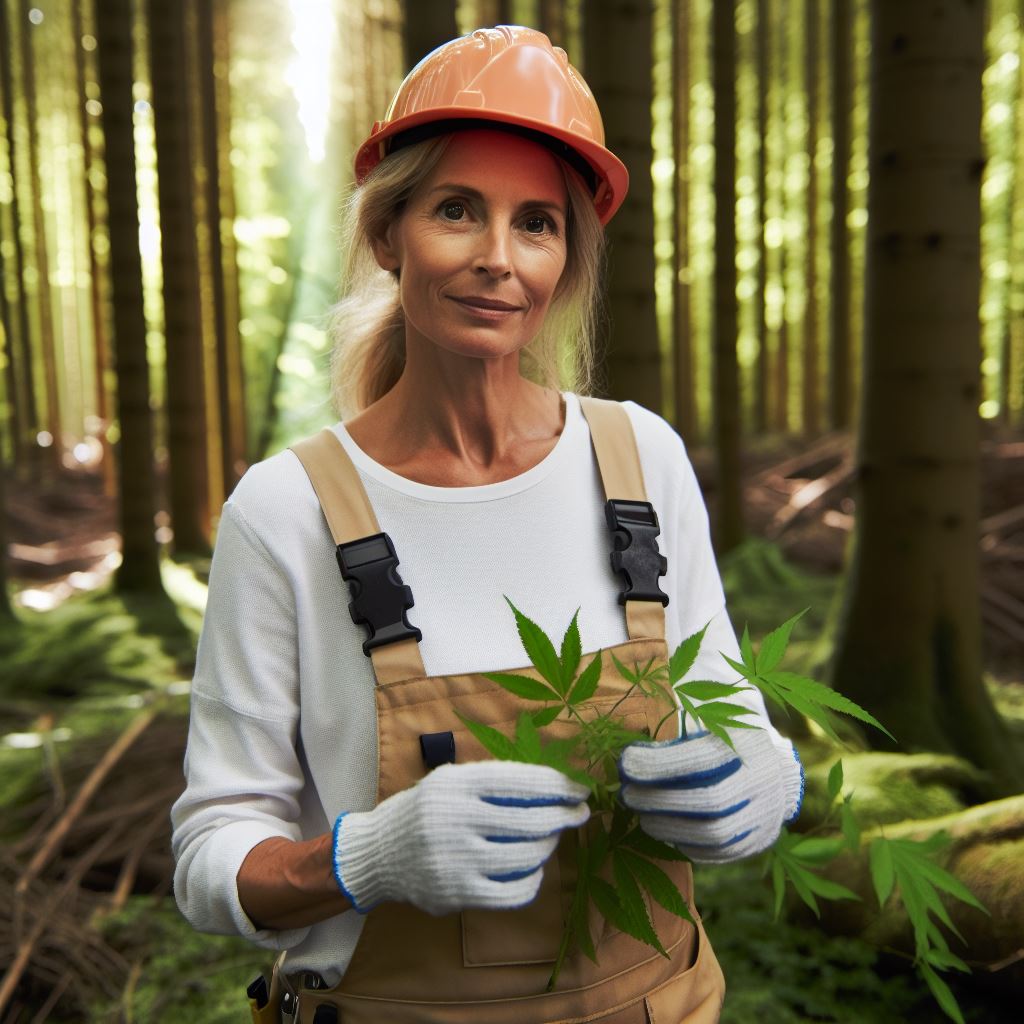Introduction
Role of foresters in managing and preserving woodlands
Woodlands in the UK play a crucial role in supporting biodiversity and providing ecosystem services.
They contribute to the economy through timber production and recreational activities.
The role of foresters is essential in managing and conserving these woodlands.
Foresters are trained professionals responsible for planning, implementing, and monitoring sustainable forestry practices.
They assess the health of woodlands, conduct surveys, and develop management plans to promote biodiversity conservation and maintain a healthy ecosystem.
Foresters play a vital role in ensuring that woodlands are properly managed, addressing issues such as pests, diseases, and invasive species.
They work closely with landowners, stakeholders, and communities to develop sustainable management practices that balance economic, environmental, and social needs.
Through their expertise, foresters can identify tree species suitable for specific locations, improving forest resilience and promoting natural regeneration.
Significance of woodlands in the UK
Furthermore, foresters promote sustainable timber production, ensuring that woodlands are harvested responsibly and replanted.
They monitor and control harvesting operations, ensuring compliance with regulations and minimizing environmental impact.
By practicing sustainable forestry, foresters contribute to the UK’s goal of achieving net-zero carbon emissions by 2050.
In addition, foresters are involved in woodland conservation initiatives.
They collaborate with conservation organizations and local communities to protect valuable habitats, promote native woodland restoration, and implement measures to enhance biodiversity.
Through their work, foresters contribute to the preservation of rare and endangered species, safeguarding the natural heritage of the UK.
Most importantly, woodlands in the UK are of significant importance, and foresters play a critical role in their management and preservation.
Their expertise and dedication ensure the sustainability of woodlands, protecting biodiversity, supporting the economy, and providing various ecosystem services.
By valuing and investing in the role of foresters, the UK can have well-managed woodlands that benefit both current and future generations.
Importance of Woodlands
The ecological and environmental benefits of woodlands
Woodlands play a vital role in our ecosystem, providing numerous ecological and environmental benefits.
They serve as habitats for a diverse range of wildlife, supporting biodiversity and promoting the overall health of ecosystems.
Woodlands act as natural carbon sinks, absorbing and storing carbon dioxide, thus mitigating the effects of climate change.
Furthermore, woodlands help in preventing soil erosion, as the roots of trees hold the soil in place, reducing the risk of landslides and maintaining water quality by filtering runoff.
They also contribute to the regulation of water cycles, preventing floods by absorbing excess water during heavy rainfall and releasing it gradually.
The economic and social importance of woodlands
Woodlands have a significant impact on the environment, but they also hold great economic and social importance.
In terms of economics, woodlands provide a renewable source of timber, which is utilized in various industries such as construction, furniture making, and paper production.
Forestry and associated industries generate employment opportunities, contributing to local economies.
Woodlands also offer recreational spaces for the public, providing opportunities for activities such as walking, hiking, and camping.
These areas promote physical and mental wellbeing, allowing individuals to connect with nature and escape the stresses of urban life.
Additionally, woodlands are ideal settings for educational purposes, providing a platform for environmental education and research.
In terms of social importance, woodlands offer a sense of community and connection to nature.
People often visit woodlands for leisure activities, picnics, and family outings.
They serve as gathering places for communities, hosting events and festivals that celebrate nature and local traditions.
Woodlands also have a cultural significance, as they are often depicted in literature, art, and folklore, symbolizing tranquility and natural beauty.
To further highlight the significance of woodlands, let us examine a list of specific benefits they provide:
Ecological and Environmental Benefits
Habitat for wildlife
Woodlands support a wide range of plant and animal species, promoting biodiversity.
Carbon sequestration
Trees absorb carbon dioxide, helping to reduce greenhouse gas emissions and combat climate change.
Soil conservation
Woodland trees prevent soil erosion, maintaining soil quality and preventing landslides.
Water regulation
Woodlands regulate water cycles, reducing the risk of flooding and ensuring a sustainable water supply.
Personalized UK Career Consulting
Receive tailored career guidance designed just for you. Get actionable steps and expert support to boost your career in 1-3 days. Take control of your career now.
Get StartedAir purification
Trees filter pollutants from the air, improving air quality and human health.
Economic and Social Importance
Timber production
Woodlands provide a sustainable source of timber for various industries.
Employment opportunities
Forestry and associated industries generate jobs, contributing to local economies.
Educational purposes
Woodlands serve as platforms for environmental education and research.
Cultural significance
Woodlands have a deep-rooted cultural importance, symbolizing natural beauty and tranquility.
Basically, woodlands are of immense importance for both the environment and society.
They provide countless ecological benefits, economic opportunities, and social value.
Preserving and managing woodlands is essential for maintaining a sustainable and balanced ecosystem, as well as ensuring the overall wellbeing of communities.
Let us cherish and protect these valuable natural resources for future generations.
Read: UK Farming Subsidies: Understanding the Basics
Responsibilities of Foresters
Foresters in the UK play a vital role in the management and conservation of woodlands. They have a range of responsibilities, including:
Managing woodland ecosystems
Managing woodland ecosystems, which involves tree planting, maintenance, and ensuring biodiversity.
Conducting surveys and assessments of woodlands
Conducting surveys and assessments of woodlands to gather data on their condition and identify any issues.
Implementing conservation and restoration projects
Implementing conservation and restoration projects to enhance the health and resilience of woodlands.
Controlling pests and diseases
Controlling pests and diseases that can damage forest ecosystems and compromise the sustainability of timber production.
Harvesting timber sustainably
Harvesting timber sustainably, following guidelines and regulations to minimize the impact on the environment.
Promoting public education and awareness
Foresters champion sustainable timber harvesting, adhering to regulations for minimal environmental impact.
They collaborate with landowners and communities, fostering woodland awareness.
In tandem with ecologists and wildlife experts, foresters manage ecosystems, overseeing tree planting and maintenance.
They monitor tree health, addressing diseases and promoting sustainable practices.
Surveys inform foresters on woodland conditions, enabling biodiversity assessment and invasive species monitoring.
They lead conservation projects, enhancing woodland health and protecting endangered species.
Pests and diseases are diligently managed through identification and targeted control measures.
Guiding sustainable timber harvesting, foresters plan logging activities, ensuring compliance with regulations to preserve soil, water, and wildlife habitats.
They actively promote public education, organizing programs to underscore woodlands’ value in carbon sequestration and biodiversity.
Overall, UK foresters play a pivotal role in diverse responsibilities—from managing ecosystems to implementing conservation projects.
Their work ensures sustainable woodland management, protecting nature and fostering public understanding.
Your Dream Job Starts with a Perfect CV
Get a tailored CV and cover letter that captures your unique strengths and stands out in your industry. Let us help you make an unforgettable first impression.
Get StartedRead: UK Crop Farming: Trends and Techniques

Education and Training
Educational requirements to become a forester in the UK
The education and training required to become a forester in the UK are essential for a successful career in managing woodlands and forests.
Professional associations and certifications available for foresters
To become a professional forester in the UK, a bachelor’s degree in forestry, woodland ecology, or a related field is typically required.
This education equips individuals with the necessary knowledge and skills to handle the complexities of woodland management.
In addition to a degree, gaining relevant work experience is crucial in this field.
Many universities offer placement years or internships to give students hands-on experience in forestry operations, forest conservation, and woodland ecology.
Continuous professional development is highly important for UK foresters.
The field of forestry is continually evolving, and foresters need to stay updated with the latest research, techniques, and regulations.
This can be achieved through attending workshops, conferences, and seminars.
Foresters can also benefit from joining professional associations, such as the Royal Forestry Society (RFS) and the Institute of Chartered Foresters (ICF).
These associations provide networking opportunities, publications, and further training resources for their members.
Many certifications and qualifications are available for UK foresters to enhance their expertise and demonstrate their commitment to professional standards.
The Professional Diploma in Forestry offered by the ICF is one such qualification that requires individuals to demonstrate their practical skills and knowledge in various aspects of forestry.
Other certifications, such as the Chain of Custody certification from the Forest Stewardship Council (FSC), are essential for foresters involved in timber production.
This certification ensures that timber is sourced from sustainably managed forests.
Importance of continuous professional development
Foresters can also pursue specialization certifications, such as the Arboricultural Association’s Tree Survey and Inspection qualification.
This qualification focuses on tree health and safety assessment, an essential skill for foresters managing woodlands with public access.
Continuing education and training are vital for foresters to keep up with the ever-changing field of woodland management.
New research, technologies, and best practices emerge regularly, and staying updated is crucial for ensuring sustainable and effective forest management.
Therefore, becoming a forester in the UK requires a bachelor’s degree in forestry or a related field, along with relevant work experience.
Continuous professional development through training, conferences, and memberships in professional associations is essential for ongoing learning and networking.
Certifications and qualifications further enhance a forester’s expertise and demonstrate their commitment to professional standards.
Challenges and Issues
Challenges faced by foresters in managing woodlands
Ensuring the maintenance and improvement of woodland biodiversity.
Protecting woodlands against pests, diseases, and invasive species.
Dealing with the impact of climate change on woodlands, such as extreme weather events.
Optimize Your LinkedIn for Success
Boost your LinkedIn profile with a professional bio, keyword-rich headline, and strategic recommendations that attract recruiters. Stand out from the crowd and get noticed.
Optimize NowBalancing commercial forestry with the conservation of natural ecosystems.
Managing the increasing demand for timber while safeguarding the long-term health of woodlands.
Issues such as climate change, invasive species, and habitat fragmentation
Climate change poses a significant challenge for foresters in UK woodlands.
They must adapt their management practices to mitigate the effects of rising temperatures, changing rainfall patterns, and increased risks of pests and diseases.
Invasive species, such as the non-native grey squirrel, can cause damage to native trees and impact biodiversity.
Habitat fragmentation, caused by factors like urban development and infrastructure, reduces the size and connectivity of woodlands, affecting wildlife movement and gene flow.
Need for sustainable forestry practices and balancing interests
Foresters in the UK recognize the importance of sustainable forestry practices to ensure the long-term viability of woodlands.
This includes promoting natural regeneration, selective harvesting, and maintaining appropriate areas of old-growth forests.
Balancing the interests of different stakeholders, including the timber industry, conservation organizations, and local communities, is crucial.
Collaborative efforts are needed to find solutions that meet environmental, social, and economic needs.
To effectively manage UK woodlands, foresters face numerous challenges and issues, including biodiversity conservation, climate change adaptation, invasive species control, and habitat fragmentation.
Sustainable forestry practices and the need to balance various interests are vital aspects of their role.
By addressing these challenges and working towards sustainable management, foresters play a crucial role in ensuring the health and vitality of UK woodlands for both present and future generations.
Read: Modern Fishing Gear: UK Fishermen’s Toolkit
See Related Content: Foresters’ Impact on UK Biodiversity
Delve into the Subject: UK Farm Management: Salary & Growth Prospects
Success Stories and Case Studies
Examples of successful woodland management projects
In the field of woodland management, foresters in the UK have achieved remarkable success through various projects.
Let’s delve into a few inspiring success stories and case studies that demonstrate the crucial role of foresters and the positive impact they have on biodiversity and local communities.
Balmoral Castle Woodland Regeneration Project
In partnership with local forestry agencies, foresters at Balmoral Castle implemented an innovative approach to regenerate the woodland areas.
Through selective tree felling and plantation of native species, they successfully restored the ecosystem, resulting in increased biodiversity and improved habitat for wildlife.
The project’s meticulous planning and execution not only ensured the sustainable future of the woodlands but also created recreational opportunities for the local community, including nature trails and guided walks.
The Forest of Dean Community Outreach
Foresters in the Forest of Dean devised an inclusive approach to engage the local community in woodland management practices.
They organized workshops and educational programs to raise awareness about the importance of sustainable forestry.
The initiative resulted in active community participation, with local schools and residents actively joining hands with foresters in tree planting and maintenance activities.
This collaborative effort has not only enhanced the biodiversity of the woodlands but has also fostered a sense of pride and ownership among the locals.
Innovative Techniques in Thetford Forest
In Thetford Forest, foresters embraced innovative techniques to improve woodland resilience and counteract the effects of climate change.
Through extensive research and experimentation, they introduced new forestry practices such as close-to-nature silviculture and continuous cover forestry.
These techniques prioritize the preservation of natural forest structures and minimize disruptions to the ecosystem.
As a result, Thetford Forest has become a haven for endangered species and a prime example of sustainable woodland management in the UK.
The Lynford Arboretum Restoration
Foresters in the Lynford Arboretum undertook a restoration project to revive the historical and botanical significance of the woodland.
By carefully analyzing historical records and plant specimens, they identified and reintroduced several rare tree species.
The restoration efforts not only preserved the arboretum’s heritage but also attracted visitors, contributing to the local economy and tourism sector.
Additionally, the presence of diverse tree species has enhanced ecosystem stability and provided valuable research opportunities.
Collaboration with Wildlife Trusts
Foresters across the UK have forged partnerships with Wildlife Trusts to integrate biodiversity conservation with woodland management.
Through joint efforts, they have implemented agroforestry systems, created wildlife corridors, and established nature reserves within woodlands.
These collaborations have led to the recovery of endangered species such as red squirrels and dormice.
Moreover, they have increased public appreciation for the ecological value of woodlands and their positive impact on local communities.
These success stories and case studies exemplify the pivotal role of foresters in UK woodlands.
By embracing innovation, collaboration, and sustainable practices, they are ensuring the preservation and flourishing of these precious ecosystems for future generations to enjoy.
The role of foresters in UK woodlands
In the intricate dance between humans and nature, foresters emerge as indispensable architects of the vibrant ecosystems that define UK woodlands.
As we unravel the layers of their multifaceted role, it becomes evident that their impact resonates across the environmental, economic, and societal spectra.
Foresters, as stewards of the environment, actively contribute to the preservation of biodiversity.
Through sustainable practices like selective harvesting and afforestation initiatives, they mitigate the adverse effects of climate change, ensuring the longevity of our woodlands as resilient ecosystems.
The importance of their work for the environment, economy, and society
In the economic sphere, foresters strike a delicate balance between resource extraction and conservation.
Their efforts not only sustain the forestry sector but also foster economic stability, creating a harmonious synergy between nature and commerce.
On a societal front, the influence of foresters extends beyond the forest’s edge.
The woodlands they nurture become recreational havens, enhancing the well-being of communities.
The quality of life improves, thanks to the green lungs they meticulously manage.
Appreciation for the unsung heroes—the foresters—holds paramount importance. Supporting their endeavors is an investment in
To appreciate and support the efforts of foresters in managing and preserving woodlands
Let us, as stewards of our collective environment, recognize, celebrate, and actively support the tireless efforts of foresters.
In doing so, we ensure that the delicate balance they maintain endures, securing the beauty and vitality of UK woodlands for posterity.
Read: UK Fishing Laws: What Every Fisherman Must Know
Conclusion
In the enchanting narrative of UK woodlands, foresters emerge as protagonists, actively sculpting the destiny of these lush landscapes.
Their role, multifaceted and nuanced, intricately weaves together the threads of environmental preservation, economic sustainability, and societal well-being.
Within the realm of environmental stewardship, foresters wield their expertise to preserve biodiversity and combat the relentless impacts of climate change.
Through strategic practices such as selective harvesting, reforestation endeavors, and the championing of sustainable forest management, they stand as guardians of the delicate balance that sustains our woodlands.
Economically, the significance of their work reverberates through the forestry sector.
Foresters, through a delicate dance of resource extraction and conservation, not only ensure the longevity of woodlands but also foster a resilient and robust economic ecosystem.
Their efforts become a linchpin, contributing not just to the preservation of nature but also to the economic stability of the regions they inhabit.
On the societal front, the influence of foresters extends far beyond the forest’s edge.
The woodlands they nurture become more than a collection of trees; they transform into recreational havens, fostering a connection between communities and nature.
The quality of life is enhanced as individuals find solace, inspiration, and a sense of well-being in these green sanctuaries.
Appreciation for these unsung heroes—the foresters—is not just a gesture; it is an acknowledgment of their pivotal role in the symphony of life.
[E-Book for Sale]
500 Cutting-Edge Tech Startup Ideas for 2024 & 2025: Innovate, Create, Dominate
$19.99 • 500 Tech Startup Ideas • 62 pages
You will get inspired with 500 innovative tech startup ideas for 2024 and 2025, complete with concise descriptions to help you kickstart your entrepreneurial journey in AI, Blockchain, IoT, Fintech, and AR/VR.




